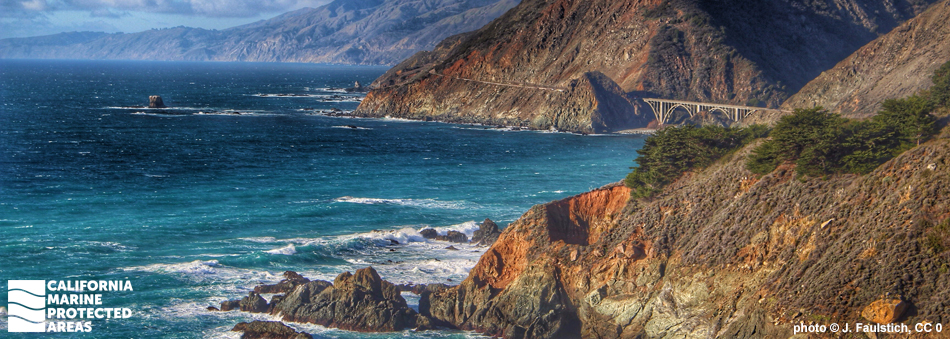
Overview
Big Creek State Marine Reserve (SMR) and Big Creek State Marine Conservation Area (SMCA) are found along a stretch of rugged and isolated coastline near the southern border of Monterey County. The two adjacent marine protected areas (MPAs) are located about 18 miles south of the town of Big Sur, and are visible from Highway 1. Big Creek SMR overlaps a portion of Landels-Hill Big Creek Reserve, a scientific research preserve owned by the University of California.
Due to their location in a remote area with limited coastal access, Big Creek SMR and Big Creek SMCA are rare examples of nearly pristine marine ecosystems. Together these MPAs cover more than 22 square miles, stretching from shore out to the three-nautical-mile state waters limit, at depths greater than 2,300 feet.
Big Creek SMR protects more than 14½ square miles of sandy beaches and seafloors, rocky tidepools and reefs, kelp forests, surfgrass beds, and over 3½ square miles of submarine canyon habitat. Big Creek SMCA protects nearly eight square miles of sandy seafloor, rocky reef, and kelp forest habitat, including nearly 2½ square miles of submarine canyon habitat. Kelp, surfperch, limpets, urchins, rockfish, cabezon, kelp greenling, southern sea otters, and countless seabirds are among the many species that thrive in these MPAs.
Regulations
Big Creek SMR
It is unlawful to injure, damage, take, or possess any living, geological, or cultural marine resource.
Except as pursuant to Federal law or emergency caused by hazardous weather, it is unlawful to anchor or moor a vessel in waters shallower than 10 fathoms (60 feet) in Big Creek State Marine Reserve.
California Code of Regulations Title 14, Section 632(b)(85)(opens in new tab)
Big Creek SMCA
It is unlawful to injure, damage, take, or possess any living, geological, or cultural marine resource, EXCEPT:
Recreational and commercial take of salmon and albacore is allowed. Commercial take of spot prawn is allowed.
California Code of Regulations Title 14, Section 632(b)(86)(opens in new tab)
Quick Facts
Big Creek SMR
MPA size: 14.51 square miles
Shoreline span: 6.1 miles
Depth range: 0 to 2,393 feet
Habitat composition*:
Habitat composition*:
- Rock: 1.90 square miles
- Sand/mud: 13.70 square miles
Big Creek SMCA
MPA size: 14.51 square miles
MPA size: 7.85 square miles
Depth range: 107 to 1,964 feet
Habitat composition*:
Habitat composition*:
- Rock: 0.03 square miles
- Sand/mud: 7.82 square miles
*Habitat calculations are based on three-dimensional area and may exceed the total MPA area listed above.